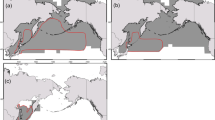Synopsis
Prey selection by underyearling bream and roach was studied in both the laboratory and field. When presented with cladoceran and a more elusive copepod prey both fish species select against copepods, regardless of the relative prey sizes. However, the field diet of bream, but not roach, consistently includes a large proportion of copepods. The explanation for this discrepancy lies in the timing and location of foraging in the field. Bream foraging, unlike that of roach, is largely restricted to the hours of darkness and to the lowest stratum of the lake. The Microcrustacea of this stratum is depleted of cladocerans at night, because of vertical migration, and is relatively rich in copepods.
Similar content being viewed by others
References cited
Berst, A.H. & A.M. McCombie. 1963. The spatial distribution of fish in gill nets. J. Fish. Res. Board Can. 20: 735–742.
Bohl, E. 1980. Diel pattern of pelagic distribution and feeding in planktivorous fish. Oecologia 44: 368–375.
Brooks, J.L. 1968. The effects of prey size selection by lake planktivores. Syst. Zool. 17: 272–291.
Charnov, E.L. 1976. Optimal foraging: the marginal value theorem. Theor. Popul. Biol. 9: 129–136.
Christiansen, D.G. 1976. Feeding and behaviour of northern pike (Esox lucius Linneaus). M.Sc. Thesis, University of Alberta, Calgary. 302 pp.
Confer, J.L. & P.I. Blades. 1975. Omnivorous zooplankton and planktivorous fish. Limnol. Oceanogr. 20: 571–579.
Cramp, S. 1985. The birds of the western Palearctic, Vol. 4, Oxford University Press, Oxford. 960 pp.
Cramp, S. & K.E.L. Simmons. 1977. The birds of the western Palearctic, Vol. 1. Oxford University Press, Oxford. 720 pp.
Cramp, S. & K.E.L. Simmons. 1983. The birds of the western Palearctic, Vol. 3. Oxford University Press, Oxford. 913 pp.
Dumont, H.J., I. Van de Velde & S. Dumont. 1975. The dry weight estimate of biomass in a selection of Cladocera, Copepoda, and Rotifera from the plankton, periphyton and benthos of continental waters Oecologia 19: 75–97.
Harden Jones, F.R. 1956. The behaviour of minnows in relation to light intensity. J. Exp. Biol. 33: 271–281.
Hutchinson, G.E. 1967. A treatise on limnology. Vol. 2, Introduction to lake biology and the limnoplankton. Wiley, New York. 1115 pp.
Ivlev, V.S. 1961. Experimental ecology of the feeding of fishes. Yale Univ. Press, New Haven. 302 pp.
Kettle, D. & W.J. O'Brien. 1978. Vulnerability of arctic zooplankton species to predation by small lake trout. J. Fish. Res. Board Can. 35: 1495–1500.
Kramer, D.L., D. Manley & R. Bourgeois. 1983. The effect of respiratory mode and oxygen concentration on the risk of aerial predation in fishes. Can. J. Zool. 61: 653–665.
Krebs, J.R., J.T. Erichsen, M.I. Webber & E.L. Charnov. 1977. Optimal prey selection in the great tit (Parus major). Anim. Behav. 25: 30–38.
Mann, R.H.K. 1982. The annual food consumption and prey preferences of pike (Esox lucius) in the River Frome, Dorset. J. Anim. Ecol. 51: 81–95.
Milinski, M. 1984. A predator's costs of overcoming the confusion effect of swarming prey. Anim. Behav. 32: 1157–1162.
Mittelbach, G.G. 1981. Foraging efficiency and body size: a study of optimal diet and habitat use by bluegills. Ecology 62: 1370–1386.
Moss, B. 1983. The Norfolk Broadland: experiments in the restoration of a complex wetland. Biol. Rev. 58: 521–561.
O'Brien, W.J. 1979. The predator-prey interaction of planktivorous fish and zooplankton. Amer. Sci. 67: 572–581.
Peirson, G. 1986. The ecology of coarse fish in Alderfen Broad, with special reference to recruitment and early life history. Ph.D. Thesis, University of East Anglia, Norwich. 203 pp.
Peirson, G., M. Cryer, I.J. Winfield & C.R. Townsend. 1987. The impact of reduced nutrient loading on the fish community of a small isolated lake, Alderfen Broad. Proc. Brit. Freshwater Fish. Conf. (4th) Univ. Liverpool: 167–175.
Persson, L. 1985. Optimal foraging: the difficulty of exploiting different feeding strategies simultaneously. Oecologia 67: 338–341.
Pyke, G.H., H.R. Pulliam & E.L. Charnov. 1977. Optimal foraging: a selective review of theory and tests. Quart. Rev. Biol. 52: 137–154.
Sokal, R.R. & F.J. Rohlf. 1981. Biometry. Freeman & Co., San Francisco. 859 pp.
Townsend, C.R. & R.N. Hughes. 1981. Maximising net energy returns from foraging. pp. 86–108. In: C.R. Townsend & P. Calow (ed.) Physiological Ecology: An Evolutionary Approach to Resource Use. Blackwell, Oxford.
Townsend, C.R. & A.J. Risebrow. 1982. The influence of light level on the functional response of a zooplanktivorous fish. Oecologia 53: 293–295.
Townsend, C.R. & I.J. Winfield. 1985. The application of optimal foraging theory to feeding behaviour in fish. pp. 67–98. In: P. Tytler & P. Calow (ed.) Fish Energetics: New Perspectives. Croom Helm, London.
Townsend, C.R., I.J. Winfield, G. Peirson & M. Cryer. 1986. The response of young roach Rutilus rutilus to seasonal changes in abundance of microcrustacean prey: a field demonstration of switching. Oikos 46: 372–378.
Vinyard, G.L. 1980. Differential prey vulnerability and predator selectivity: effects of evasive prey on bluegill (Lepomis macrochirus) and pumpkinseed (L. gibbosus) predation. Can. J. Fish. Aquat. Sci. 37: 2294–2299.
Vinyard, G.L. & W.J. O'Brien. 1976. Effect of light intensity and turbidity on the reactive distance of bluegill sunfish. J. Fish. Res. Board Can. 33: 2845–2849.
Werner, E.E. 1984. The mechanisms of species interactions and community organization in fish. pp. 360–382. In: D.R. Strong, D. Simberloff, L.G. Abele & A.B. Thistle (ed.) Ecological Communities: Conceptual Issues and the Evidence. Princeton University Press, Princeton.
Winfield I.J. 1983. Comparative studies of the foraging behaviour of young co-existing cyprinid fish. Ph.D. Thesis, University of East Anglia, Norwich. 209 pp.
Winfield, I.J. & C.R. Townsend. 1983. The cost of copepod reproduction: increased susceptibility to fish predation. Oecologia 60: 406–411.
Winfield, I.J., G. Peirson, M. Cryer & C.R. Townsend. 1983. The behavioural basis of prey selection by underyearling bream (Abramis brama (L.)) and roach (Rutilus rutilus (L.)). Freshwat. Biol. 13: 139–149.
Author information
Authors and Affiliations
Rights and permissions
About this article
Cite this article
Winfield, I.J., Townsend, C.R. Factors affecting prey selection by young bream Abramis brama and roach Rutilus rutilus: insights provided by parallel studies in laboratory and field. Environ Biol Fish 21, 279–292 (1988). https://doi.org/10.1007/BF00000376
Received:
Accepted:
Issue Date:
DOI: https://doi.org/10.1007/BF00000376




